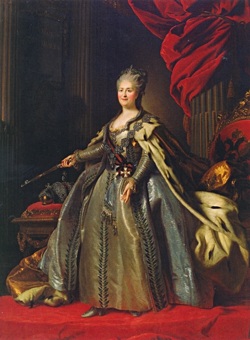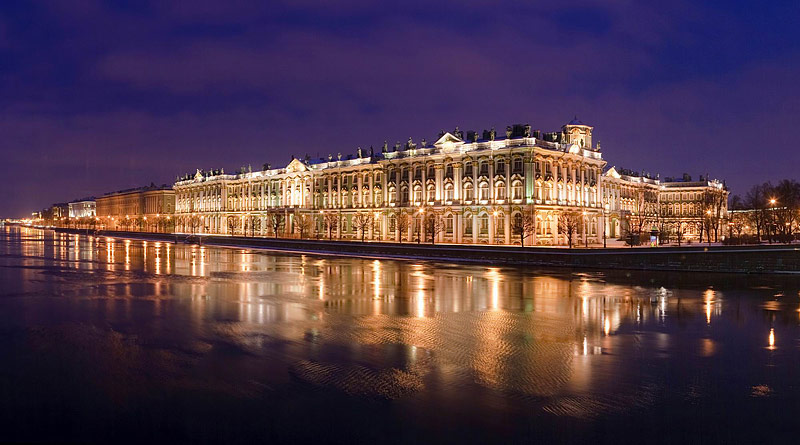Snow. Communism. Cold War. Red Square. Vodka. Tsars.
These may be the first things that come to mind when we encounter the name “Russia”. This huge country in Eastern Europe, with a land area that covers one-sixth of the whole planet, grew to be very powerful. This progress happened due to two of Russia’s greatest rulers, Peter the Great and Catherine the Great.
Before their respective reigns, Russia was a backward country overshadowed by other Western European countries that had many scientific and technological advancements and developments. Russia did not have any of these, until it came under the reigns of Peter the Great and Catherine the Great, who led cultural revolutions in Russia in two entirely different centuries.
 |
| Peter the Great |
He strengthened the army as well as the navy. His fascination with science and technology combined with his childhood interest in warfare inspired him to build a strong army and navy. Before his reign, the Russian army was very weak and comprised of mere villagers who had little knowledge about warfare. By what he saw in his travels to other countries, particularly England and Holland, he was motivated to strenghten his nation’s armed forces. Following the industrial success he engineered, Russia became the world’s top producer of iron, which in turn enabled Russians to the produce their own weapons. More importantly, military training was uniform to everyone to turn the army into professional soldiers. Towards this end, Peter the Great brought military experts from other countries and ordered for the construction of ships which he himself designed.
Changes in people’s lifestyles. Prior to Peter’s reign, the Russian men wore long beards and were used to sleep with their shoes on, a habit they carried for centuries as followers of the Russian Orthodox Church. Russian men were not used to shave their beards because these represented their religion’s ideas of manhood. But, as Peter traveled across Europe, he saw how different the Russians were and so wanted his own people to be similar with the other Westerners he encountered. Hence, he ordered all men to cut their long beards off and to remove their shoes when in bed. Basically, he wanted them to act more like progressive Westerners, and even encouraged the Russians to dress up just the way foreigners did. Now, the question: what happened if someone disobeyed him? Well, to those who did not shave their beards, heavy taxes were imposed on violators. But worse, those who did not remove their shoes when going to bed had to deal with this stern personal order: “Ladies and gentlemen of the court caught sleeping with their boots on will be instantly decapitated.” Enough said, no one dared to violate the master’s order.
Most importantly, he founded a great city called... St. Petersburg. As you can guess, he founded it and named it after himself. However, by adjoining a reference to St. Peter in naming the city, he was in effect identifying himself with the side of the first pope of the Catholic Church. As such, he also moved the Russian capital from Moscow to St. Petersburg, and ordered the establishment of schools, churches and palaces. One of the most well-known landmarks is the Peterhof Palace, which, in German, means “Peter’s Court.” Interestingly, it is also known as the “Russian Versailles” due to its majestic appearance and grandeur, and is famous for its parks, gardens, and fountains. Now, St. Petersburg is known as one of the most beautiful cities in the world and is also the location of many commercial and international establishments. Due to its Western aura, it is often dubbed as Russia’s “window to the West”.
 |
| Peterhof Palace, St. Petersburg |
 |
| Catherine the Great |
She established numerous schools, including a school for girls. Probably the most famous school that Catherine the Great established is the Smolny Institute for Noble Maidens, which aimed to “educate women, good mothers and useful members of family and society.” In this particular school, strict measures were used to ensure the students’ discipline as they grew up.
She expanded Russia’s territories. Just like Peter the Great, Catherine was able to expand Russia’s borders. The difference was that Catherine successfully obtained a huge portion of the lands on the south and west of Russia, which Peter was not able to do. The Russian empire got that much bigger when it occupied Crimea, Ukraine, Poland as well as other areas in Central Europe. This was the result of Russia’s successful battles against the Ottoman Turks as well as the Poles and the Swedes.
She founded the Hermitage Museum and built (more) palaces. The Hermitage Museum can be found in five adjacent buildings, one of which is the famous Winter Palace. This museum houses more than 2 million art exhibits, including those by famous painters such as Michelangelo and Vincent Van Gogh. The Hermitage is known to be the largest art gallery in Russia, and is so huge it would take a visitor eleven years to see all the exhibits kept there.
 |
| Winter Palace, St. Petersburg |
Today, Russia has lost possession of some of the territories that they once proudly annexed. Under a communist regime, national priorities have changed. But even then, at least the world will remember that two great rulers planted the seeds from which a progressive culture grew in Russia, that eventually gave the world first class ballet, orchestras, composers like Peter Tchaikovsky and Sergei Rachmaninoff, periodic table inventor Dmitri Mendeleev, and many more. Without these, people around the world not have enjoyed life the way they do today.
Indeed, the Russia of today has become some kind of an irony. Culturally, it has made countless contributions towards the development of world culture. At the same time, however, it has become threat to world peace because of its military adventurism under a communist regime. How the balance will be tipped is something we will have to see.
Sources:
Aleksandrova, Kristina. “Catherine’s Maidens – Beautiful, Plain, Noble.” The Moscow Times. The Moscow Times, 2010. Web. 19 July 2014.
“Catherine the Great (1729-1796).” BBC History. n.p., 2014. Web. 19 July 2014.
“Catherine the Great Biography.” History of Russia. n.p., 2012. Web. 19 July 2014.
Cheney, Ian. “How Peter the Great Modernized Russia.” Construction Magazine. n.p., 2013. Web. 18 July 2014.
Delaroche, Paul. Peter the Great. 1838. Fine Arts Museum of San Francisco, San Francisco. Peter the Great Music Academy. Web. 20 July 2014. Gilligan, Maggie & Linder, Samantha. “Major Accomplishments.” Catherine the Great. n.p., n.d. Web. 19 July 2014.
“Grand Cascade and Palace in Peterhof, St. Petersburg.” Photograph. Peterhof Palace and Garden (Petrodvorets). Viator, 2011. Web. 20 July 2014.
Kipreeva, Alyona. “Peter III.” Russiapedia. n.p., n.d. Web. 7 Aug 2014. Massie, Robert K. Nicholas and Alexandra. New York: Dell Publishing, 1985. Print. “Peter III.” Bio. A&E Television Networks, 2014. Web. 23 July 2014.
“Peter III.” RusArtNet.com. n.p., 2012. Web. 4 Aug 2014. “Peter III (Emperor of Russia).” Encyclopedia Britannica. Encyclopedia Britannica, 2014. Web. 4 Aug 2014. “Peter the Great.” History Learning Site. n.p., 2006. Web. 19 July 2014.
“Peter the Great – Military Reforms.” History Learning Site. n.p., 2006. Web. 6 Aug 2014. “Peter the Great Accomplishments.” History of Russia. n.p., 2012. Web. 19 July 2014.
“Peter the Great, Reigned 1682-1725.” Royal Museums Greenwich. National Maritime Museum, 2014. Web. 19 July 2014.
“Peterhof (Petrodvorets).” Saint-Petersburg.com. n.p., 2014. Web. 19 July 2014. Rokotov, Fyodor. Portrait of Catherine II. 1780. Hermitage, St. Petersburg. WikiArt.org. Web. 20 July 2014. Scicluna, Ken. “Winter Palace.” Photograph. St. Petersburg in 11.5 Hours. Condé Nast Traveler, 2012. Web. 20 July 2014.
“September 5 in History.” Russiapedia. n.p., n.d. Web. 4 Aug 2014. “St. Petersburg.” Lonely Planet. Lonely Planet, 2014. Web. 19 July 2014. “The State Hermitage Museum.” Saint-Petersburg.com. n.p., 2014. Web. 19 July 2014.
Article by Venice
Artwork by Tamika
----
Venice has been an ardent lover of anything connected to history since childhood, may these be novels, movies, or songs.




The art and architecture are to die for in St. Petersburg, especially in the Peterhof and Catherine palaces. I remember asking though how they manage to repaint their buildings every three years or so (and in such pastel colors too) and apparently it's part of tax. I mean it sounds kinda silly but it's way better than our useless inflated 30+% tax that goes into people's pockets
ReplyDelete